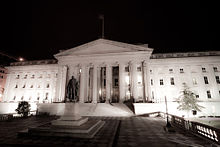Neel Kashkari
Neel Tushar Kashkari[1] (born July 30, 1973) is an American banker, economist and politician who is the president of the Federal Reserve Bank of Minneapolis.
He was named the new president of the Minneapolis Federal Reserve November 10, 2015, succeeding Narayana Kocherlakota who announced his resignation in June.
[4] After completing his master's degree, Kashkari moved to Redondo Beach in California, and worked as an engineer for TRW Inc., a contractor for NASA.
[6] After graduation from Wharton in 2002, he joined Goldman's San Francisco office as an associate[14] covering software companies in the investment banking division.
This caused a housing glut and crisis as the banks holding the mortgages saw their assets decline in value and rushed to foreclose the loans.
He led Treasury's participation in the Hope Now Alliance, a mortgage industry initiative coordinated by the federal government that aimed to reduce foreclosures by modifying loan terms on a loan-by-loan basis.
[20][23] In March 2008 he represented Treasury at negotiations that led ultimately to the federally sponsored takeover and rescue of the investment bank Bear Stearns by JPMorgan Chase.
[7] In early 2008, Paulson directed Kashkari and fellow Treasury aide Phillip Swagel to write a plan to recapitalize the banking system in case the crisis worsened.
The plan was conceived as an alternative to proposals from the staff of the House Financial Services Committee, then led by Democratic Representative Barney Frank.
[28] Following the collapse of the investment bank Lehman Brothers on September 15, 2008, the Emergency Economic Stabilization Act of 2008 (EESA) was enacted on October 3.
[29] Based in large part on Kashkari and Swagel's recapitalization plan, the EESA created the Troubled Asset Relief Program (TARP), a $700 billion bailout fund for financial institutions threatened with collapse.
[15] Noticing a lack of necessary expertise in investment within Treasury, Kashkari recruited new staff for the program, some from government and others from industry, ultimately hiring about 100 people by January 2009.
[35] With Bush scheduled to leave office on January 20, 2009, following the November 2008 election, Kashkari's appointment was initially viewed as temporary.
[36] However, after Obama won the election, his transition team asked Kashkari to remain at Treasury after the inauguration for a limited period.
[17] Neil Barofsky, who oversaw TARP within Treasury as a special inspector general, commended Kashkari's commitment to the job but criticized his actions.
[39] Elizabeth Warren, who headed TARP's Congressional Oversight Panel, later criticized Kashkari for allegedly promising to focus on smaller banks shortly before Treasury announced additional measures to bail out Citigroup.
"[41] One week after his resignation, he and his wife moved to a cabin in rural Northern California near Lake Tahoe as part of what he called a "detox" from Washington.
[45][46] In 2015, the Wall Street Journal said that "the performance of [Pimco equity] funds Mr. Kashkari launched was spotty [and] the firm has since closed some of" them.
[47] Kashkari has said he first considered running for Governor of California after Republican nominee Mitt Romney lost the 2012 presidential election to Obama.
[48] He spent the year after his resignation from Pimco preparing to campaign in the 2014 gubernatorial election, touring the state, hiring a staff, and meeting with potential donors.
[53] Brown was widely expected to finish first in the primary, so Kashkari's principal opponent at this stage was his main rival for second place, Republican state assemblyman Tim Donnelly.
[56] Republican donors Charles Munger Jr. and Robert Addison Day also spent $400,000 supporting Kashkari through an independent expenditure committee.
Kashkari's moderate views on social issues, involvement with TARP, and vote for Obama in 2008 were unpopular with many Republican voters,[59] who were more enthusiastic about Donnelly.
[51] Kashkari, by contrast, spent almost all his campaign money to beat Donnelly,[65] and additional financial support from the national or state Republican Parties was unlikely.
His campaign disputed some aspects of the reporting and said that Kashkari's Treasury Department service proves his commitment to civic life.
[77] On social issues, he has described himself as libertarian[78] and "a different kind of Republican",[72] supporting abortion rights, same-sex marriage, and a path to legal status for illegal immigrants.
[71] In 2013, he was one of 131 Republicans who signed a pro-marriage equality amicus curiae brief submitted to the U.S. Supreme Court as part of Hollingsworth v. Perry,[79] the case in which the final appeal against the previously-found unconstitutionality of Proposition 8 was rejected for lack of standing.
Economists and political experts interviewed by the Los Angeles Times were skeptical of the plan's chances in the Democratic-dominated California Legislature and of its potential effectiveness were it to be passed.
[83] In January 2020, Kashkari and Alan Page proposed amending a portion of the Minnesota State Constitution to read, "All children have a fundamental right to a quality public education that fully prepares them.
They married in a traditional Hindu ceremony in Chicago, and she supported him through his time at Wharton while working as an engineer at Northrop Grumman.



Brown: 50–60% 60–70% 70–80% 80–90%
Kashkari: 50–60% 60–70% 70–80%

